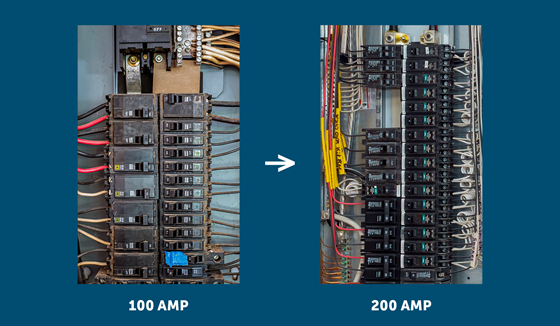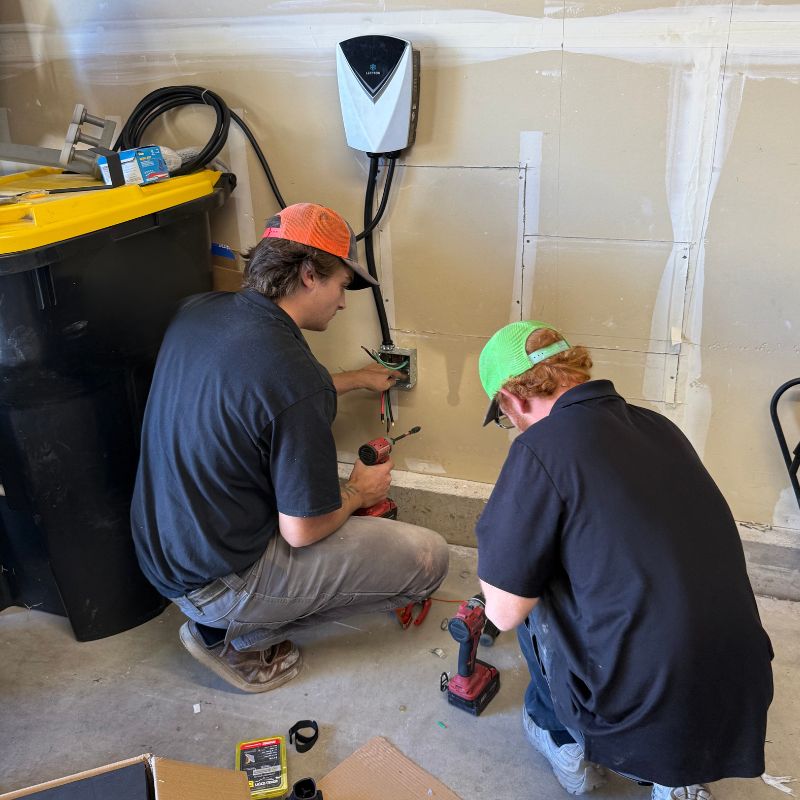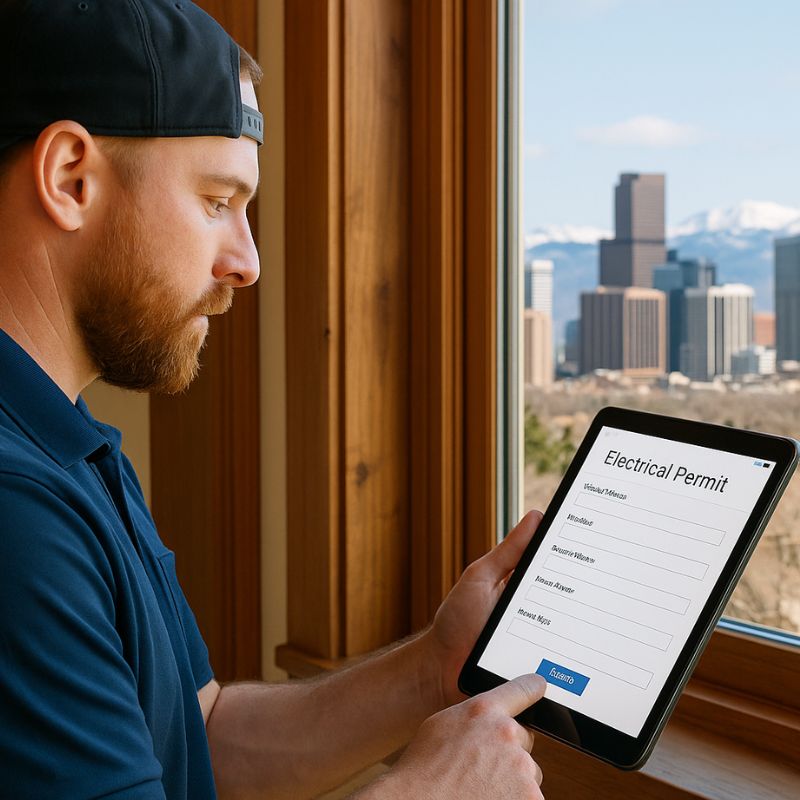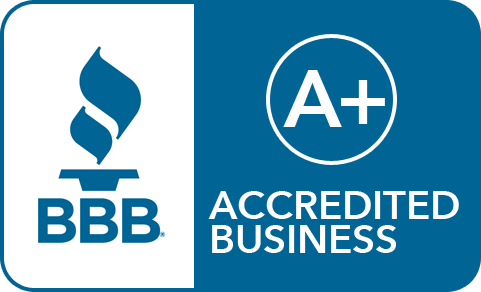Contents
- What Is an Overloaded Circuit?
- What Causes an Electrical Circuit Overload?
- What Happens When a Circuit Is Overloaded?
- How to Fix an Overloaded Circuit
- Can an Overloaded Circuit Fix Itself?
- What Happens If You Have Too Many Things Plugged In?
- Preventing Circuit Overload: Smart Solutions for Colorado Homes
- FAQs
- Conclusion
If you’ve ever blown a fuse right after plugging in the toaster and microwave at the same time, congratulations — you’ve just met the mighty overloaded circuit.
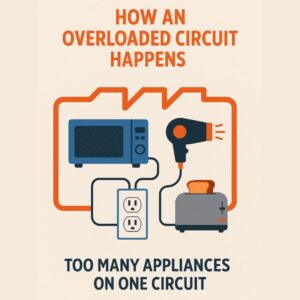
It’s one of the most common electrical issues in homes across Colorado, and while it may seem like a small inconvenience, it can lead to major hazards if ignored.
In this guide, we’ll explain what an overloaded circuit is, why it happens, how to fix an overloaded circuit, and when it’s time to call a licensed electrician (hint: sooner is usually better).
What Is an Overloaded Circuit?
An overloaded circuit happens when the electrical demand on a circuit exceeds the amount of electricity it was designed to handle.
Every circuit in your home has a specific amperage limit — typically 15 or 20 amps — that determines how much current it can safely carry.
When you plug in too many devices or high-powered appliances on the same circuit, the wires heat up, the breaker trips, and your power shuts off. That’s your electrical system’s way of saying, “I’m overloaded — help!”
Example:
Let’s say you have your space heater, hairdryer, and curling iron all plugged into the same bathroom outlet. That circuit might handle one of those just fine — but not all three at once.
The result? Lights flicker, the breaker trips, and you’re left wondering if the house is haunted.
What Causes an Electrical Circuit Overload?
Overloading of a circuit can happen for several reasons, and most of them come down to how modern households use power-hungry devices on outdated wiring.
Here are the most common causes:
Too Many Devices Plugged In:
Every appliance draws a certain amount of current. When multiple high-wattage devices share the same circuit, it’s a recipe for overload. Think space heaters, microwaves, coffee makers, and vacuums all running at once.
Old or Undersized Wiring:
Many older Colorado homes were built before modern electrical demands existed. That 15-amp circuit from 1970 wasn’t designed to handle today’s energy-hungry devices like large TVs, gaming consoles, and smart appliances.
Faulty Breakers or Loose Connections:
Even a properly loaded circuit can become dangerous if the breaker or wiring is damaged. Loose connections or faulty components increase resistance, causing wires to heat up faster.
Extension Cord Overuse:
Extension cords might seem like an easy fix for not having enough outlets, but they can quickly push circuits beyond capacity — especially when daisy-chained together.
What Happens When a Circuit Is Overloaded?
When an electrical circuit is overloaded, several things can happen — and none of them are good news.
Tripped Circuit Breaker:
This is your first line of defense. The breaker automatically cuts off power to prevent overheating.
Flickering or Dimming Lights:
If lights flicker when you turn on an appliance, it’s a red flag that the circuit is straining.
Warm or Discolored Outlets:
Heat buildup can warp or discolor outlet covers, signaling excess current flow.
Burning Smell or Smoke:
That faint burning odor near an outlet or switch? It’s a warning that wires may be melting — and an immediate safety hazard.
Electrical Fires:
If the overload isn’t corrected, insulation can melt, leading to short circuits and potentially devastating fires.
Bottom line: An overloaded circuit is not something that “fixes itself.” If left unaddressed, it can quickly turn from a nuisance into a full-blown emergency.
How to Fix an Overloaded Circuit
Wondering how to fix an overloaded circuit safely? Here’s a practical step-by-step approach:
1. Turn Off and Unplug Devices
If your breaker trips, switch off or unplug everything connected to that circuit. This relieves the electrical load immediately and prevents further damage.
2. Reset the Breaker
Once the load is removed, reset the tripped breaker in your panel. It should stay on if the overload issue was temporary.
3. Identify the Source of Overload
Determine what caused the trip. Was it a space heater, power tool, or too many kitchen appliances? Understanding the cause helps prevent recurrence.
4. Redistribute Electrical Load
Plug high-wattage devices into different circuits to balance demand. For example, use a separate outlet on another circuit for your microwave or vacuum cleaner.
5. Upgrade Your Electrical System
If overloads happen often, your home may need additional circuits or an electrical panel upgrade. The Electricians can evaluate your setup and recommend safe, energy-efficient solutions.
6. Call a Licensed Electrician
If your outlets feel warm, you smell burning, or the breaker keeps tripping — do not ignore it. Contact The Electricians, Colorado’s trusted professionals, for a thorough inspection and lasting fix.
Can an Overloaded Circuit Fix Itself?
In short — no.
While a tripped breaker might reset and restore power, the underlying cause remains. Circuits don’t “heal” or “self-correct.”
Continuous overloading only wears down your electrical components faster, increasing the risk of fire or equipment failure.
If your circuit repeatedly trips, it’s a sign that your system needs attention — not patience.
What Happens If You Have Too Many Things Plugged In?
Plugging too many things into a single outlet or circuit can cause:
- Voltage Drops: Your devices may not receive consistent power, leading to poor performance or malfunction.
- Overheating: The wires behind your walls can get dangerously hot.
- Tripped Breakers: A warning sign that your home’s electrical load needs balancing.
This is especially common during colder months when heaters, holiday lights, and kitchen appliances all compete for power.
If that sounds familiar — you’re not alone. Many Colorado homeowners run into this problem every winter.
Preventing Circuit Overload: Smart Solutions for Colorado Homes
Keeping your circuits safe doesn’t have to mean living like it’s 1950. Here are some modern ways to prevent overloads and save energy in the process:
1. Smart Electrical Panels
A smart electrical panel, like the SPAN Panel, gives you real-time insight into your home’s energy use. It helps you monitor which circuits draw the most power and manage your load efficiently.
2. Dedicated Circuits for Heavy Appliances
Appliances like HVAC systems, EV chargers, and dryers should each have their own dedicated circuits to prevent overload.
3. Regular Electrical Inspections
Schedule an annual home electrical inspection to catch problems before they escalate. The Electricians offer professional inspections across Colorado to keep your system safe and compliant.
4. Upgrade Old Wiring
If your home still relies on outdated wiring or an old panel, upgrading to modern standards improves safety, efficiency, and home value.
FAQs
What Is an Overloaded Circuit?
An overloaded circuit occurs when too much electrical current flows through a circuit designed for less power, causing overheating and tripped breakers.
How to Fix an Overloaded Circuit?
Start by unplugging devices, resetting the breaker, and redistributing load across multiple circuits. If the problem persists, call a licensed electrician to assess your wiring and capacity.
Can an Overloaded Circuit Fix Itself?
No. Breakers may reset temporarily, but the problem will return until you correct the source of overload or upgrade your electrical system.
What Happens If You Plug in Too Many Devices?
Too many devices can overheat wires, trip breakers, and even start electrical fires. Avoid using multiple high-wattage appliances on the same circuit.
Conclusion
Overloaded circuits are like a warning light on your electrical dashboard — ignore them long enough, and they’ll cause serious damage.
Whether your breakers trip once a month or every other day, it’s worth investigating the root cause.
At The Electricians, we help Colorado homeowners fix overloaded circuits, upgrade panels, and keep homes running safely and efficiently.
Schedule a free estimate today and protect your home from hidden electrical hazards.
Related Posts
If you enjoyed reading this, then please explore our other articles below:

